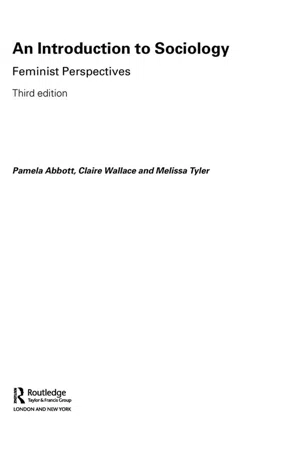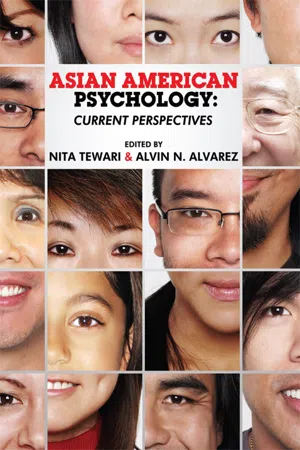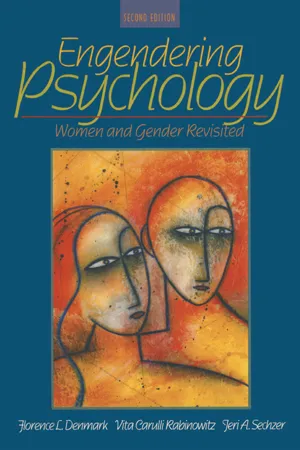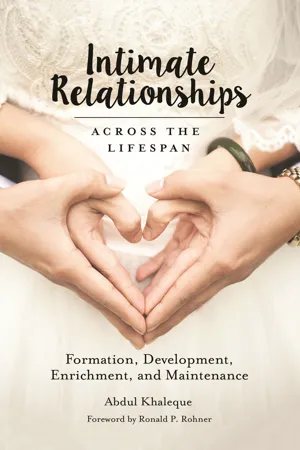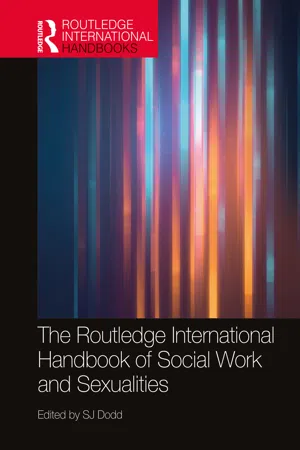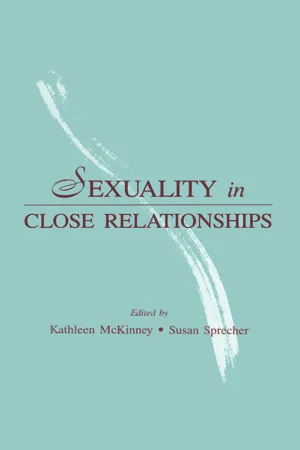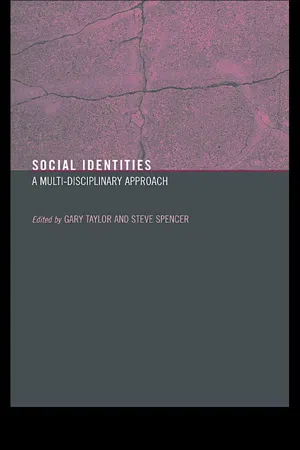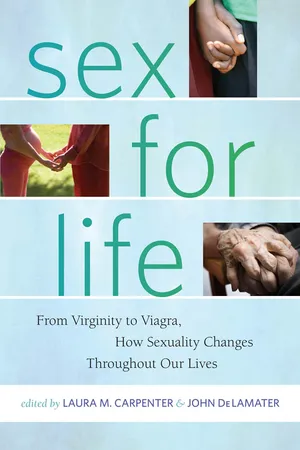Social Sciences
Sexuality in America
"Sexuality in America" refers to the diverse range of sexual attitudes, behaviors, and identities within the United States. It encompasses cultural, social, and political aspects, and has been shaped by historical, religious, and legal influences. The study of sexuality in America involves examining issues such as sexual orientation, gender identity, sexual health, and the impact of societal norms and values.
Written by Perlego with AI-assistance
Related key terms
10 Key excerpts on "Sexuality in America"
- eBook - ePub
An Introduction to Sociology
Feminist Perspectives
- Pamela Abbott, Melissa Tyler, Claire Wallace(Authors)
- 2006(Publication Date)
- Routledge(Publisher)
CHAPTER EIGHTSexuality
Sexuality is generally taken to refer to the social experience and expression of physical bodily desires, real or imagined, by or for others or for oneself. It encompasses erotic desires, identities and practices. Seemingly one of the most private, intimate aspects of our lives, sociologists have argued that sexuality is fundamentally social and political. This is because sexuality is experienced and expressed within relations of power and exchange and what we think of as sexual varies historically and culturally as well as in different social contexts. Sociologists have therefore argued that no human sexual behaviour or practice can be divorced from the social and political circumstances in which it takes place, and the social relations within which it is embedded. This means that even individual sex acts (such as masturbation or other forms of auto-eroticism) are social acts because the way in which we think about and make sense of them is shaped by a range of social values, attitudes, norms and sanctions. Yet sexuality remains something of a neglected topic in sociology when compared to say social class or the mass media, brought onto the sociological agenda only relatively recently. Largely as a result of the contribution of feminist sociologists and political activists sexuality has now begun to emerge as a legitimate focus of sociological concern. Indeed, that New Right movements in many Western societies have mobilised considerable political energies through their emphasis on the sanctity of the family, hostility to gay and lesbian sexuality and to ‘sexual deviance’ of various kinds is, as Jeff Weeks (1991, p. 12) has noted, something of a ‘back-handed compliment to the success of feminism’.Sexuality has been one of the main concerns of feminist theory and politics not least because feminists regard men’s control of women’s sexuality as one of the key mechanisms through which patriarchy is maintained. Feminists have drawn attention to the social control of women’s sexuality through religious, state and medical regulatory practices. In particular, feminists have emphasised the role of sexuality in reinforcing patriarchal power relations, highlighting issues such as pornography, sexual violence, clitoridectomy, prostitution and ‘compulsory heterosexuality’ (Rich, 1980) – the social compulsion to be heterosexual. Feminists have also made a significant contribution to theorising sexuality and the sexual body. They have also highlighted the relative neglect of issues of sexual identity in the social model of disability (Lloyd, 2001). Many have argued that the so-called ‘sexual revolution’ has merely been a means of increasing and legitimating a male right of sexual access to women. Others have highlighted, however, the ways in which sexuality can be a means of challenging and resisting women’s oppression. Feminist contributions have also drawn attention to the ways in which so-called scientific perspectives (including those developed by social scientists) have served to perpetuate women’s sexual oppression. - eBook - ePub
Sexuality
A Psychosocial Manifesto
- Katherine Johnson(Author)
- 2015(Publication Date)
- Polity(Publisher)
Despite Helen Merrell Lynd’s warning polarization between psychological and socio-historical approaches has been an all too familiar feature of late twentieth-century thought, particularly in the field of sexuality. In reviewing prominent theories and debates it is reasonable to claim that this polarization constitutes a ‘kind of conceptual impasse’, found in many accounts influenced by either Marx or Freud, or latterly Freud and Foucault, whose vital work sets the scene for contemporary understandings of sexuality within academia and everyday life. This book explores the polarization between psychological and socio-historical accounts that are documented well in sexuality studies and somewhat ambitiously proposes an alternative, a psychosocial manifesto that seeks to stitch and mend the polarization. Yet, as Sedgwick states, trying to remedy, or even articulate the impasse is not without its own problems. Specifically, in trying to articulate accounts of sexuality without recourse to a polarization between psychology and historicism invites us to engage with the ‘psychosocial’, but inevitably within this articulation it is difficult not to fall back on the mechanisms that constitute the split.The term sexuality can refer to a set of practices or behaviours, a range of feelings or affects, or as a way of categorizing people on the basis of their sexual orientation, sexual identity or political allegiances. The plural, sexualities, is utilized to acknowledge the multiple meanings of sexuality and to recognize that an understanding of contemporary sexuality needs to engage with a proliferation of identity categories, sexual practices, subjectivities, desires and relationship formations, including for example queer or trans alongside more familiar categories such as heterosexual, lesbian, gay and bisexual. This book explores the way in which the term is conceptualized in an array of psychological and social debate, such as neuroanatomy, adolescent development, sexual health, youth suicide, identity politics or gay marriage, and provides access to a range of theoretical perspectives that seek to explain how sexuality is developed, constructed, queered, embodied and transformed.Since the late 1800s, sexologists and psychologists have tended to promote the view that sexuality has its origins in biological processes underpinned by hormones, drives, and more recently, genetics. In contrast, historians and sociologists point to the social field as the defining force that shapes the meanings given to sexuality and sexual experience. This observation provides the starting point for investigating how polarization produces different forms of knowledge and the impact these have on how sexuality can be experienced in personal and political contexts. Such distinctions are familiar within social science accounts of sexuality, but they are also apparent within the humanities and queer studies. For example, Michael Warner (1993) expressed a similar warning to Lynd in the seminal text Fear of a Queer Planet - eBook - ePub
Asian American Psychology
Current Perspectives
- Nita Tewari, Alvin N. Alvarez, Nita Tewari, Alvin N. Alvarez(Authors)
- 2008(Publication Date)
- Psychology Press(Publisher)
The chapter will discuss a range of issues regarding Asian Americans and sexuality, such as identity development, socialization, behaviors, sexual health, and sexual violence. The chapter will also cover how social and cultural issues impact sexuality for Asian Americans. “Now let's talk about sex, baby.. . . ” Although there has been increased discussion about sexuality in Asian Americans in the humanities, there are few empirical studies in psychology on sexuality and the sexual identity of Asian Americans (Okazaki, 2002). The extant studies on Asian Americans mainly examined sexual attitudes and behavior and not sexual identity development (Chng & Geliga-Vargas, 2000; Cochran, Mays, & Leung, 1991; Huang & Uba, 1992; Meston, Trapnell, & Gorzalka, 1996). The silence in the Asian American community surrounding sexuality presumably preserves this reality as sacred and pure, with one author commenting that the “invisibility and silence ironically create certain attitudes among Asian Americans toward sexuality, such as separation, shame, homophobia, and fixed gender roles” (Lee, 2006). Therefore, researching, discussing, and examining Asian American sexuality and sexual identity in depth is important to break the silence around this commonly taboo subject. Sexuality is more than one's sexual orientation —it is a continuum of identities, desires, fantasies, behaviors, and attractions, which can range from homoerotic to heterosexual (Takagi, 1994). Sexuality is the “total expression of the attempt to discharge energy from sexual drives” (Gilbert & Scher, 1999). So, why is sexuality such an important topic in psychology? Sexuality is a fundamental aspect of an individual's identity and how one relates to others. Asian American sexuality is an important topic to discuss given the stereotypes and assumptions that Asian Americans are less sexually active or, on the other extreme, sexually deviant - eBook - ePub
Engendering Psychology
Women and Gender Revisited
- Florence Denmark, Vita Carulli Rabinowitz, Jeri A. Sechzer(Authors)
- 2016(Publication Date)
- Psychology Press(Publisher)
It is hard to imagine a topic in which gender matters more than sexuality. Gender surely influences people’s patterns of sexual desire and arousal, their responses to sexual imagery, and their sexual attitudes and practices. As we will see in this chapter, sexual behavior is a response to a complex mix of sociocultural, psychological, and biological forces and cannot be adequately understood in terms of any one force alone.In this chapter, we consider physical aspects of sexuality, research on the nature and extent of various sexual behaviors, sexual orientation, sexual fantasy, responses to sexual imagery, sexuality among those with disabilities, sexual dysfunction, and contraceptive use. But we begin with a discussion of how female sexuality has been socially constructed—how social realities affect how we identify, describe, classify, and ultimately experience sexuality.SEXUALITY IN A SOCIAL CONTEXTWe take a social constructionist perspective on sexuality that focuses on the historical and cultural contexts in which sexuality is learned and practiced. This view suggests that all societies organize sexual desires, behaviors, and identities into approved or encouraged, tolerated, and tabooed patterns (Lorber, 1994). These patterns are internalized by individual members of societies, who often come to view them as natural and inevitable, even biological, in origin.Both female and male sexuality are shaped by society and culture. To be sure, societal messages to males about sex are value laden and conflicting, and may pose many emotional and sexual difficulties for them (Kilmartin, 1994). But in most societies throughout history, sexuality is made problematic for females in ways that it is not for males (Gagnon, 1977; Gagnon & Simon, 1973). Some of these problems are due to the biological fact that sexual intercourse is far more consequential for females than males, because females alone bear children. But others result from the social reality that, throughout history, males have defined sexuality, including female sexuality, from their own perspective. Because of their historically greater physical, social, and economic power, men have been in positions to define when, how, with whom, and under what circumstances sex is appropriate, and they have often done so in ways that are disadvantageous to women. For example, the very definition of what constitutes “having sex” reveals a deeply androcentric (male-centered) and heterosexist bias (see Box 8.1 ). In Western societies, having sex usually refers exclusively to vaginal intercourse, involving male penetration and ejaculation. Hugging, touching, and kissing (which for some women are more stimulating than vaginal intercourse) do not count as having sex in this formulation. If they are considered at all, it is as foreplay - eBook - ePub
Intimate Relationships across the Lifespan
Formation, Development, Enrichment, and Maintenance
- Abdul Khaleque(Author)
- 2018(Publication Date)
- Praeger(Publisher)
CHAPTER ELEVEN Sexuality Sexuality is the key to the problem of the psychoneuroses and of the neuroses in general. No one who disdains the key will ever be able to unlock the door. —Sigmund FreudFreud proposed a pansexual view of human development assuming that sexual urges and pleasures are the primary determinants of all kinds of human behavior, and the resolution of psychosexual conflicts is the key to a healthy life. Few psychologists endorse his views because of his exaggerated importance on the biological aspect of sexuality, ignoring the social and moral aspects of human sexuality. Although many psychologists find it difficult to accept his proposition that any kind of pleasure is related to sex, nobody denies his view that a healthy sexual relationship is an important determinant of a healthy adult intimate relationship and psychological adjustment.Thus sexuality is considered an important component of intimate relationships or close personal relationships. Today there is more openness in expressing sexuality than at any time in the past, especially in Western countries including the United States. Moreover, sexual activity is accepted as a pleasurable, healthy, normal, and positive human behavior. One major change in attitude toward sexuality in Western societies is marked by the greater acceptance of premarital and nonmarital sex in a loving relationship, and more openness, less opposition, and more acceptance of homosexual and bisexual relationships. Another significant change in sexual attitude in Western societies is the decline in the double standard on sex—more sexual freedom for men than women.Sexual Attitudes and BehaviorA survey on sexual attitudes and behavior shows that Americans have different types of views about sexuality. Laumann and Michael (2000), for example, found that about 30 percent of Americans have a traditional or reproductive attitude toward sex. They think that sexual activity should be permissible within the marital relationship for reproductive purposes. Approximately 25 percent of Americans (more men than women) hold a recreational view about sex. This group thinks that sex is for enjoyment, and as long as people enjoy sex and it does not hurt anyone, it should be okay. About 45 percent of Americans have a relational view about sex. They think that sex should be in loving relationships, but not necessarily in the marital relationship only. - eBook - ePub
- Steven Seidman, Nancy Fischer, Chet Meeks, Steven Seidman, Nancy Fischer, Chet Meeks(Authors)
- 2007(Publication Date)
- Routledge(Publisher)
In this part, you’ll be introduced to different social perspectives on sexuality. These should not be seen as mutually exclusive; rather, they are conceptual resources that can help you to understand the complexities of sexual meanings and practices. You’ll be treated to interviews with two leading researchers in the sociology of sexuality. You’ll learn not only about their social research but something of the political and moral motivations of their sociology of sexuality.Passage contains an image
1 Theoretical perspectivesSteven Seidman State University of New York, AlbanyWhat is the relationship between sex and society? Beginning with sexologists who propose a view of sex as fundamentally biological, I review various social approaches to understanding sexuality. I take for granted the belief that there is a biological basis for human impulses, drives, and desires. However, it is social forces that fashion a biological reality into “sexuality.” Individuals and groups give meaning to bodily sensations and feelings, make erotic acts into sexual identities, and create norms distinguishing between acceptable and unacceptable sexualities.Sexology: a natural order of sexuality
Why do many of us in America and Europe view sexuality as natural? One reason is the development of a science of sexuality. In the late nineteenth and early twentieth centuries, there developed a science aimed at discovering the laws of sexuality. This science has come to be called sexology.Who are the sexologists? Among the more famous are Richard von Krafft-Ebing, Havelock Ellis, and Magnus Hirschfeld. While few of us today have heard of these nineteenth-century pioneers of sexology, many of us have heard of Alfred Kinsey or of Masters and Johnson. Sexologists have produced a body of knowledge that has influenced the way many of us think about sex, in part because their ideas have been stamped with the imprimatur of science.What are the key ideas of sexology? First, sexology claims that humans are born with a sexual nature, and that sexuality is part of the biological makeup of all individuals. Second, sexology views sexuality as being at the core of what it means to be human: our sexual drive is no less basic than our need to eat or sleep. Sexuality is said to be basic to who we are. Third, sexuality is viewed as a powerful and driving force in our behavior. It influences all aspects of our lives, from the physical to the psychological. It motivates much of human behavior. Fourth, sexology states that the sexual instinct is, by nature, heterosexual. There is said to be a natural attraction between men and women. While few sexologists today believe that the chief purpose of sexuality is to procreate, they continue to think that heterosexuality is the natural and normal form of sexuality. - SJ Dodd, SJ Dodd(Authors)
- 2021(Publication Date)
- Routledge(Publisher)
Sexual identity development is a complex process that continues throughout individuals’ lives. Much broader than sexual orientation identity, which it includes but with which it is often improperly conflated, sexual identity encompasses the entirety of individuals’ personal and social understandings and beliefs about and enactment of sexual and romantic desires, actions, and experiences (Brandon-Friedman, 2019b). While social workers historically have viewed sexuality to be outside of their professional domain, they have begun to recognize the essential role that sexual identity and its development play in their clients’ lives and the need to consider them within their practice (Brandon-Friedman, 2019b; Dodd and Tolman, 2017; McCave et al., 2014).Sexual identity development occurs in the intersections between physiological, intrapsychic, and social aspects of individuals’ lives. As discussed earlier, Cass (1979) and Troiden (1988) developed the first models of sexual identity development based on their work with gay men. Recognizing that all individuals go through a sexual identity development process, Dillon et al. (2011) developed the most comprehensive model of sexual identity development that encompasses the experiences of both heterosexual and sexual minority individuals. This model includes four interrelated dimensions, Sexual Identity Commitment, Sexual Identity Exploration, Sexual Identity Synthesis/Integration, and Sexual Orientation Identity Uncertainty. Individuals may occupy one or more places within these dimensions dependent on their level of sexual identity development. Research has indicated that more developed sexual identities contribute to better psychosocial outcomes and increased sexual well-being among both heterosexual and sexual minority individuals (Brandon-Friedman, 2019a; Brandon-Friedman et al., 2020; Muise et al., 2010).Broadly conceived, sexual development begins prior to birth as fetuses are influenced by sex chromosomes and hormones and develop their genitalia. The contemporary focus on determining and then announcing fetuses’ biological sex through events such as “gender reveal parties” (gatherings in which the sex of an unborn child, generally determined based on ultrasound imaging, is revealed to others and celebrated) starts the process of sociosexualization by assigning an assumed normative gendered and sexualized path for youth. Physiological influences continue through childhood becoming more pronounced as youth approach and progress through puberty as this is when society begins to emphasize sexuality. Social influences on sexual identity development include personal beliefs, families, peers, and media. As with sexual orientation identity development models, sexual identity development models suggest that development concludes when individuals incorporate their sexual identity into their global identities. As with gender identity, individuals can move between developmental phases as they learn new possibilities or foreclose others.- eBook - ePub
- Kathleen McKinney, Susan Sprecher(Authors)
- 2014(Publication Date)
- Psychology Press(Publisher)
And what is sexuality? As in the case of love, most researchers and writers on the topic have avoided definitions. Reiss (1986b) searched 20 human sexuality textbooks and found only 5 contained definitions of their topic, each quite different. Our own search through the literature yielded a similar paucity and a similar range. Some see human sexual behavior and motivation as "not biological but rather social and cultural phenomena" (Kon, 1987, p. 257). Or in Reiss' (1986b) words, sexuality "consists of those scripts shared by a group that are supposed to lead to erotic arousal and in turn to produce genital response" (p. 21). Others adhere to the biological understanding of sexuality as "first and foremost a mechanism by means of which species reproduce themselves" (Beach, 1977, p. 3). More typically, the definition falls somewhere in between, such as that of Strong and DeVault (1988), who described sexual behavior as "characterized by conscious physiological/erotic arousal (such as desire) and that may also be accompanied by physiological arousal ... or activity" (p. G-9).However, the core elements in most definitions seem to be physiological sexual arousal and sexual desire. Thus, we will use the following working definition: Sexuality is the constellation of sensations, emotions, and cognitions that an individual associates with physiological sexual arousal and that generally gives rise to sexual desire and/or behavior . Although this definition is structurally more complex than that of the definition of love, it also emphasizes a motivational element (sexual desire). This definition is also neutral with regard to how sexuality is constructed—biologically, developmentally, culturally, or whatever.A Dimension for Organizing Social Science Approaches to Sexuality and Love
One way to understand the variety of approaches to the relation between sexuality and love is to think of these approaches as lying along a dimension having two extremes—one arguing that love is a mere by-product of sexuality, of the physiological and behavioral reproductive systems dictated by human genes, and the other arguing that sexuality is a mere by-product of the cosmic yearning for love, for fusion, for union (see Fig. 2.1 - eBook - ePub
Social Identities
Multidisciplinary Approaches
- Steve Spencer, Gary Taylor(Authors)
- 2004(Publication Date)
- Routledge(Publisher)
Ethnicity, social class, family biography and other social divisions also create different opportunities for constructions of identity. Within this there are different degrees of passivity and resistance to normative constructs of gender and sexuality that have varying implications for individual agency and subjectivity. Compulsory sexual identity and practice Another aspect salient to sexuality and expressions of sexual identity is that differences in relation to gender, age and ethnicity have to be seen in relation to a matrix of heterosexuality and the characteristics of heterosexual desire which provide scripts for appropriate sexual practices (Butler, 1990; Rubin 1989). Numerous studies (Hirst, 2001; Hirst and Selmes, 1996; Wight, 1996; Whately, 1992; Ward and McLean Taylor, 1994; Trenchard and Warren, 1984, and Thomson and Scott, 1991) evidence knowledge of a dominant heterosexual ideology that fashions learning about sexuality in both formal and informal settings and in turn influences feelings about permissible sexual identity and practices. Sexual discourses are scripted for both sexes in exclusively heterosexual terms so that attraction to the opposite sex is assumed and reinforced, whereas attraction to the same sex rarely features in either discourse or representations. This creates a hierarchy of identities scaffolded in place by the power of heteropolar ideology. In seeking to understand the mechanisms by which these regulative powers operate Gayle Rubin (1989) in Thinking Sex arranges beliefs about ‘good’ and ‘bad’ sexuality into a diagram that identifies degrees of social acceptability and unacceptability among a range of social and sexual institutions and practices (see Rubin, 1989: 281). ‘Good’, normal, natural (i.e. ‘desirable’) sexuality is at the top of the hierarchy and includes (among several typifications) sex between heterosexuals, in couples, those who are married and have sex in private, and for a procreative purpose - eBook - ePub
Sex for Life
From Virginity to Viagra, How Sexuality Changes Throughout Our Lives
- Laura Carpenter, John DeLamater(Authors)
- 2012(Publication Date)
- NYU Press(Publisher)
Introduction Sexualities over the Life Course: The Development of a Perspective JOHN DELAMATER AND LAURA M. CARPENTER How do sexual and social experiences—childhood sex play, immigration, or divorce, for example—at one point in a person’s life affect his or her sexual beliefs and behaviors later on? How are individuals’ sexual biographies shaped by broader cultural and historical changes, such as the sexual “revolution” of the late 1960s and the early 1970s or the increasing availability of same-sex marriage? In what ways do intersections among gender, race, ethnicity, social class, and sexual orientation influence these life course processes, even as life course processes influence those intersecting social statuses in turn? We explore these questions in this book. Introduction As a relatively new area of inquiry, the study of human sexuality from a life course perspective is rapidly coming into its own. This burgeoning field began in earnest in 1994, with the publication of Alice Rossi’s highly regarded edited volume, Sexuality across the Life Course (University of Chicago Press). Since then, scholars of sexuality have greatly expanded the range of topics they study as well as the theoretical approaches they deploy. Although the sexual scripting approach remains ascendant, other perspectives—from biopsychosocial models to Foucauldian genealogies to Bourdieuian fields approaches 1 —are increasingly employed. Life course theory and research have evolved as well, with researchers increasingly replacing models of linear progress—for instance, from education to work to retirement—with perspectives positing multiple and overlapping trajectories, such as work, health, and sexuality, that extend from birth to death
Index pages curate the most relevant extracts from our library of academic textbooks. They’ve been created using an in-house natural language model (NLM), each adding context and meaning to key research topics.
